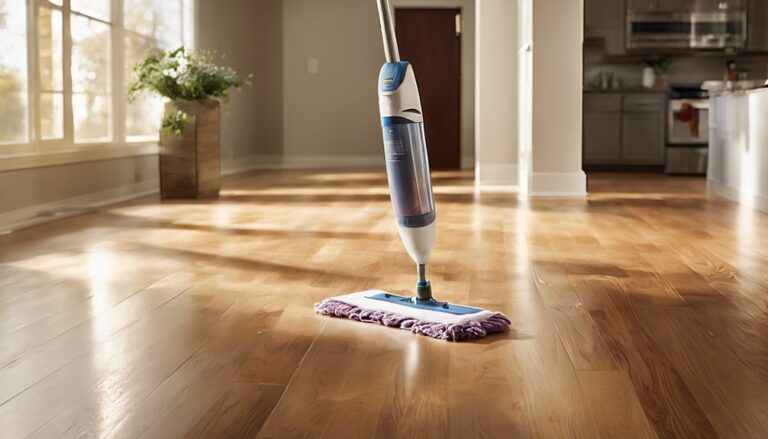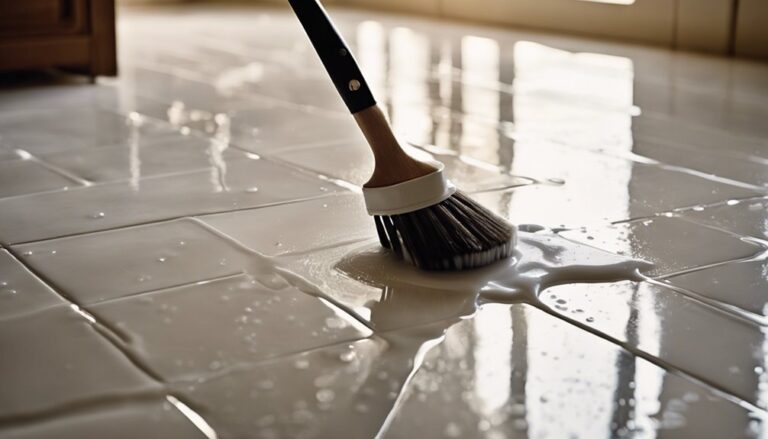To clean dirty tile floors, first identify if your tiles and grout are sanded or unsanded to choose the right cleaner. Sweep or vacuum to remove loose dirt, then mop with a mild detergent mixed in warm water, avoiding excess moisture. For grout, apply a baking soda paste or grout cleaner, scrub with a stiff brush, and rinse well. Dry tiles with a microfiber cloth to prevent streaks. Following these steps guarantees a thorough clean, and there are additional ways to keep your tiles looking fresh longer.
Identifying the Type of Tile and Grout
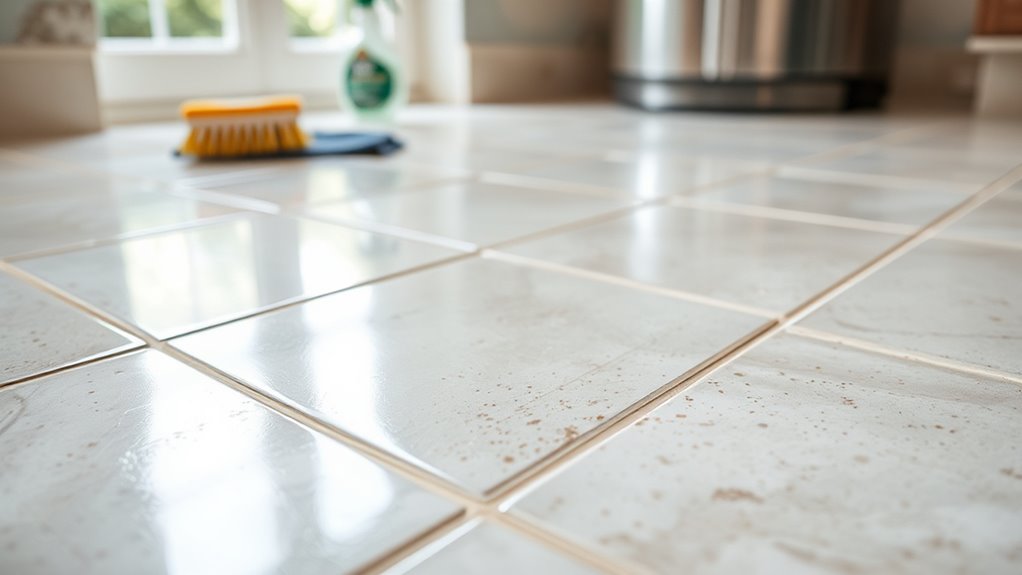
How do you determine the type of tile and grout on your pavimento before cleaning? Start by closely examining your tiles. Ceramic tiles are common, durable, and have a smooth, glazed surface. You’ll notice their uniformity and slightly cool touch. Next, inspect the grout between tiles. Grout types vary: sanded grout contains gritty particles and suits wider joints, while unsanded grout is smooth and ideal for narrow joints. You can test grout by gently scratching it with a fingernail; sanded grout feels rougher. Identifying these accurately is essential because each tile and grout type requires specific cleaning methods to avoid damage. Knowing what you’re dealing with lets you maintain your floor’s integrity, giving you the freedom to clean confidently and effectively without guesswork.
Gathering Essential Cleaning Supplies
Before you begin cleaning your tile floors, you’ll need to gather five essential supplies to guarantee an effective and safe process. First, select appropriate cleaning solutions tailored to your tile type to avoid damage while ensuring dirt removal. Next, choose scrub brushes with firm bristles—these are vital for tackling grime in grout lines without scratching tiles. A mop and bucket will help you apply and rinse cleaning solutions efficiently. Additionally, have microfiber cloths on hand for drying and spot cleaning. Finally, consider gloves to protect your hands from chemicals. By assembling these specific tools, you gain control over the cleaning process, allowing you the freedom to maintain your floors confidently and effectively without unnecessary hassle or damage.
Preparing the Floor for Cleaning
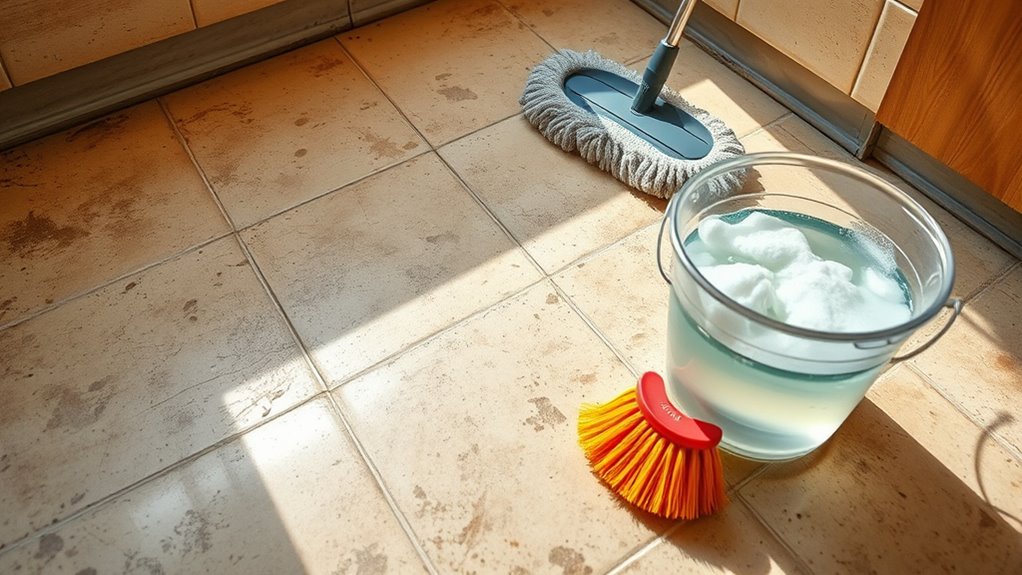
Since dirt and debris can easily scratch tile surfaces during cleaning, you’ll want to start by thoroughly sweeping or vacuuming the floor. Before that, remove any furniture to give yourself full access and prevent damage. This step also makes clearing debris more efficient, as you won’t have obstacles blocking your path. Focus on corners and grout lines where dirt tends to accumulate. Use a soft-bristle broom or a vacuum with a hard floor setting to avoid scratching. Once the floor is free of loose particles, inspect for any sticky spots or stains that’ll need special attention later. Preparing the floor carefully guarantees you’ll protect your tile’s finish and set a solid foundation for effective cleaning. Taking these precise steps helps you maintain freedom from worry about damage.
Effective Methods for Cleaning Tile Surfaces
Although tile floors are durable, effective cleaning requires using the right methods to avoid damage and maintain their appearance. Start by selecting an appropriate cleaning solution—opt for eco friendly solutions to protect both your health and the environment. Mix a mild detergent with warm water, then mop the floor thoroughly. For tougher stains, steam cleaning is an excellent choice; it loosens dirt without harsh chemicals, preserving tile integrity. Make sure you wring the mop well to prevent excess water, which can seep into grout and cause issues. After cleaning, rinse the floor with clean water to remove residue and dry it with a microfiber cloth to avoid streaks. Following these precise steps lets you maintain your tile floors’ beauty while enjoying the freedom of a clean, healthy space.
Techniques for Deep Cleaning Grout Lines
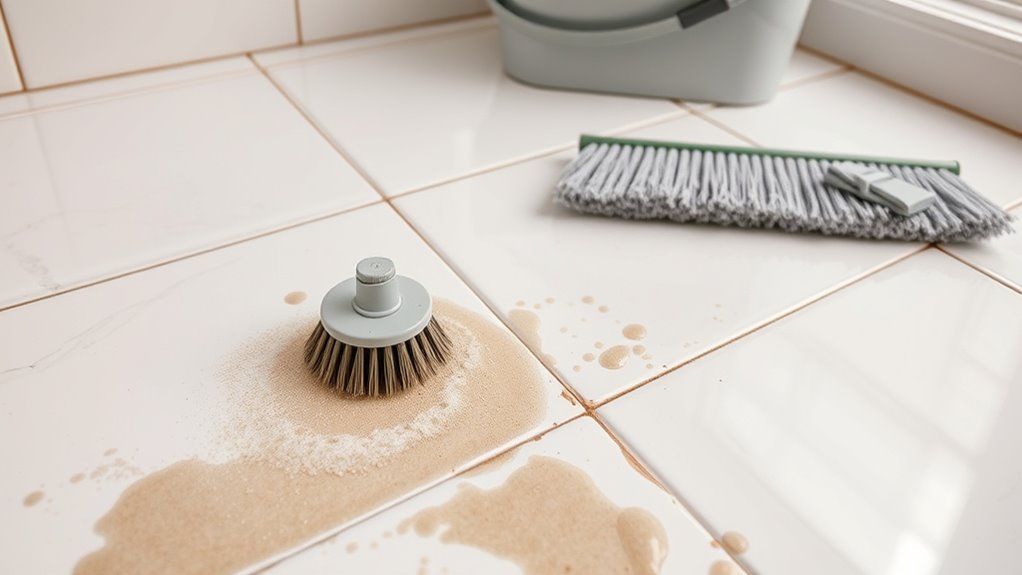
While cleaning tile surfaces keeps your floors looking fresh, grout lines often require more focused attention to remove embedded dirt and stains. To deep clean grout, start by applying a grout whitening solution or a paste made from baking soda and water. Let it sit for 10-15 minutes to break down grime. Next, use a stiff brush to scrub the lines firmly but carefully, avoiding tile damage. For a chemical-free option, steam cleaning is highly effective; the high temperature penetrates grout pores, loosening dirt and killing bacteria. After scrubbing or steaming, rinse thoroughly with warm water to lift away residue. Repeat as needed for stubborn stains. These precise techniques will restore your grout’s brightness and extend the life of your tile floor without excessive effort.
Tips for Maintaining Clean Tile Floors Regularly
To keep your tile floors looking their best, establish a daily sweeping routine to remove dirt and debris before it settles. Once a week, perform a deeper clean to tackle grime and maintain grout brightness. Additionally, adopt preventive care habits like using mats and wiping spills promptly to protect your tiles over time.
Daily Sweeping Routine
Regularly sweeping your tile floors is essential to prevent dirt and debris from accumulating and causing stains or scratches. By sticking to an effective daily schedule, you maintain your floor’s pristine condition and extend its lifespan. Here are some precise sweeping techniques to streamline your routine:
- Use a soft-bristle broom or microfiber dust mop to avoid scratching the tiles.
- Sweep in a consistent pattern, such as from one corner to the opposite side, ensuring no area is missed.
- Focus on high-traffic zones daily to prevent dirt build-up.
- Empty the dustpan or vacuum contents immediately to avoid recontamination.
Pulizia profonda settimanale
Once a week, dedicating time to deep clean your tile floors guarantees they stay in prime condition beyond daily sweeping. Establishing a weekly schedule helps maintain consistent cleaning frequency, preventing dirt buildup and grout discoloration. Start by vacuuming or sweeping thoroughly to remove loose debris. Follow with a mop soaked in a solution of warm water and a pH-neutral cleaner to avoid damaging the tile surface. Pay close attention to grout lines, using a soft brush if necessary, to lift embedded grime. Rinse with clean water to eliminate residues, then dry the floor to prevent streaks and water spots. Keeping to this methodical routine empowers you to enjoy pristine tile floors with minimal effort, preserving their appearance and extending their lifespan.
Preventive Care Tips
Maintaining the cleanliness of your tile floors goes beyond weekly deep cleaning; integrating preventive care into your routine can greatly reduce the effort needed over time. Preventive maintenance guarantees your tiles stay durable and attractive, saving you from costly repairs. To protect your investment, consider these essential tips:
- Apply protective coatings to shield tiles from stains and wear.
- Use mats or rugs at entry points to minimize dirt and grit.
- Clean spills immediately to prevent grout discoloration.
- Avoid harsh chemicals that can damage tile surfaces and coatings.


